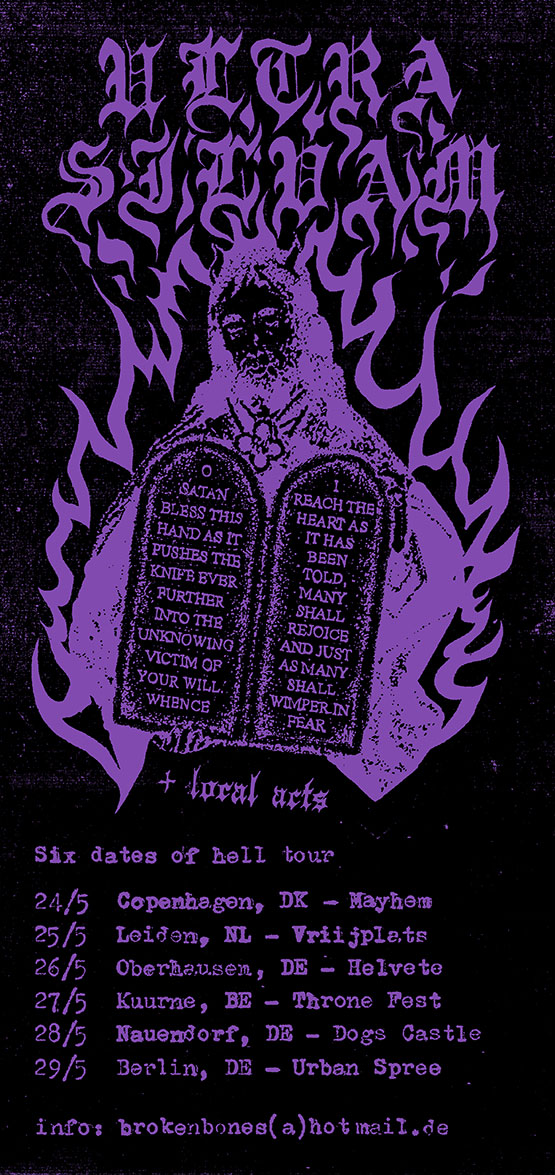Ultra Silvam
2022-05-04
by Niklas Göransson
Days of wrath – M.A. of Swedish black metal trio Ultra Silvam discusses their recently released second album, The Sanctity of Death.
– “The Sanctity of Death” is, as indicated by the title, a homage to death and the powers that I worship. All of its eight compositions go hand in hand with this concept. While sounding like a fully natural follow-up to “The Spearwound Salvation”, the new album also ushers in a new chapter for ULTRA SILVAM. The first era, which consisted of the demo and debut, was followed by a creative void as our focus shifted to live shows. Once the pandemic hit, we entered our next phase and started writing and rehearsing for “The Sanctity of Death”.
ULTRA SILVAM’s second album was released by Shadow Records on February 25, 2022. It comes three years after the band’s debut, “The Spearwound Salvation”.
– Our initial plan was to record with Marco Vermiglio (FLAMEKEEPER), who operates out of Necromorbus Studio. Every one of us has a tight schedule, yet we somehow managed to find a week that worked for all three members… but of course, Marco wasn’t available then. Waiting an additional several months to capture our vision was out of the question, so we decided to record elsewhere and then leave the mixing to Marco. Our past work was done locally here in Malmö – and had we limited ourselves to this town, we would’ve been forced to deal either with amateurs or hipsters who do not understand ULTRA SILVAM. It can work out fine, depending on what we wish to achieve, but this time around we were after something different and did not want to compromise with anything. Ultimately, our choice fell on Endarker.
Endarker Studio in Norrköping, Sweden, is owned and operated by Swedish underground veteran and former long-time MARDUK bass player Devo Andersson.
– At first, we weren’t entirely convinced about this match – considering in particular our chaotic and VENOM-like approach contrasted to Endarker‘s rather distinct spirit of sterile ‘metronome black metal’. It works great on the right record: OFERMOD’s “Tiamtü” for example, which sounds mechanical and industrial in the best way possible. ULTRA SILVAM is not a tight band by any stretch of the imagination, so we compensate with unhinged intensity. L.A. has no interest in playing like a modern metal drummer; he loathes ‘gravity blasts’ and other sophisticated techniques, preferring instead to rely on caveman-battery fuelled by sheer adrenaline.
The ‘gravity blast’ is a technique allowing drummers to play twice the amount of snare hits while exerting less effort. After the tip of the drumstick makes contact with the skin, the middle part strikes the snare’s edge – thereby providing leverage for the upstroke before the manoeuvre is repeated. The drawback is that what one gains in tempo is detracted from the volume and power. I consulted a friend who is well-versed in the art of percussion – his verdict was that gravity blasting is vile trickery mostly confined to what he refers to as ‘video game death metal’, as practised primarily by ‘acts with three or more words in their names’.
– After finishing a concert, any drummer worth his salt should be so exhausted that he can barely leave the stage by his own accord. I myself adhere to much the same approach, which became the most evident when I was both the bass player and vocalist – I wanted to sound like Cronos (VENOM). This philosophy of ours is prone to cause a bit of a culture-shock in professional studio settings like Endarker. The same has happened whenever we’ve come across rational musicians, since such an approach apparently results in disturbing frequencies and rumbling when playing sixteenth notes on bass. But so be it: this music requires some proper filth. Regardless, and despite our conflicting stylistic preferences, working with Devo went very smoothly.
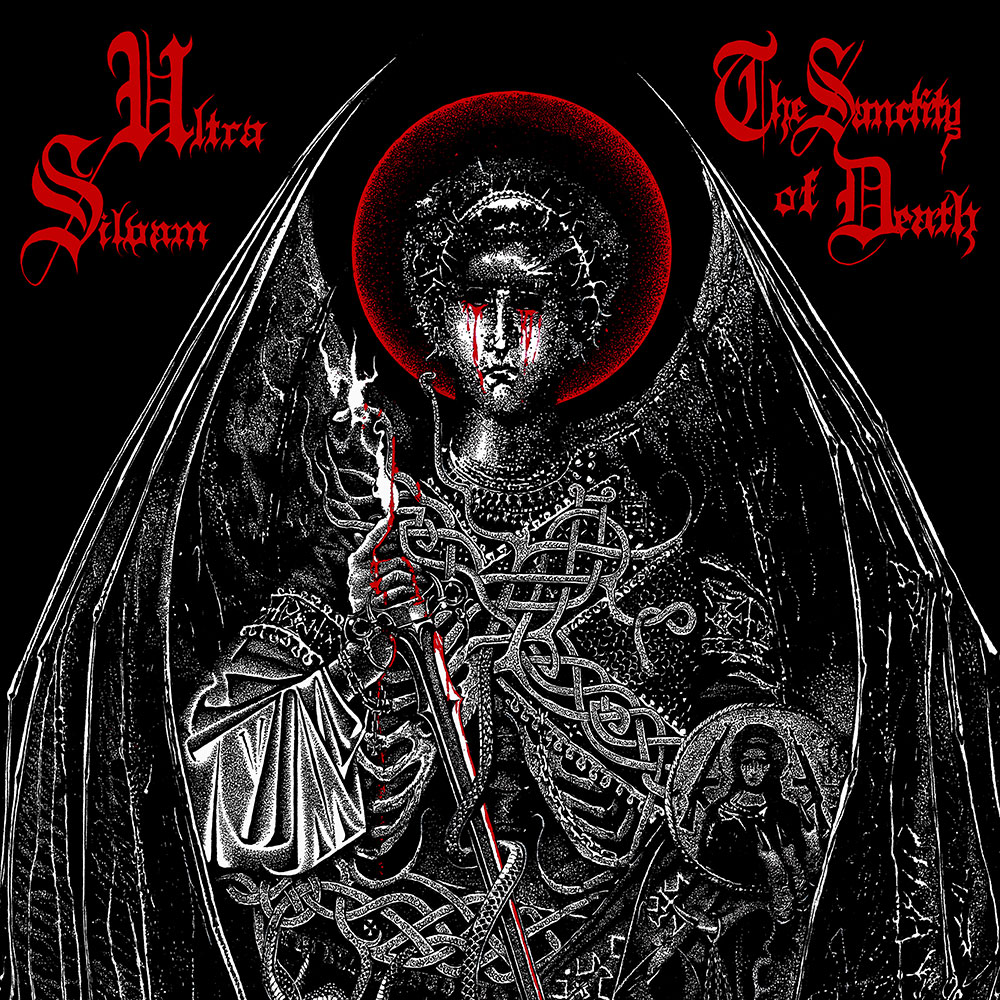
“The Sanctity of Death” was tracked in three and a half days, as opposed to the two days it took to record “The Spearwound Salvation”.
– The last time, we were in such a hurry that I ended up blowing out my voice – which is why the vocals on our first album sound the way they do. Unfortunately, this did not result in a broken “Live in Leipzig” feeling, but rather some ugly and inappropriate hardcore vocals. Luckily, I was spared such problems for this recording, so it came out a lot better.
What kind of sound were you aiming for?
– We didn’t have a clear image of what the album should be like, besides the indescribable feeling one always has beforehand. Listening to ULTRA SILVAM, I can identify certain recurring patterns that give us our unique characteristics: ones which were already set in stone by the time we made the first demo. I would argue that they are just as easily identifiable on “The Sanctity of Death” but used with increased variation. We’ve tried our hand at many new elements – clean vocals, slower tempos, unorthodox instruments, and so on – without it resulting in some pretentious rubbish far removed from what we set out to accomplish.
While much of the material is rather straightforward, there are a lot more nuances to discover on this one. Subtle choirs, bells, ABRUPTUM-sounding outros, and so forth.
– We had more time to hone all the small details which are not replicated live but provide a little extra spice to the studio versions. For example, the clean vocals on “Dies Irae” were a spontaneous improvisation made towards the end of the recording. I realised that – considering its strong fuck-the-world sentiments – this Latin sequence would fit perfectly in the still-untitled lyric. And then we named the song after it because… well, why not reference an old medieval hit?
Dies irae is a Latin poem dating back to the 13th century at the latest, but which is likely far older. It describes the biblical day of reckoning, when each mortal man is dragged before the Throne of God to receive His final judgement. The phrase that ULTRA SILVAM borrowed – ‘Dies iræ, dies illa, solvet sæclum in favilla’ – translates to ‘The day of wrath, that day, will dissolve the world in ashes.’ It took a few listens to fully process this, since my brain is hard-wired to associate that wording with DISSECTION’s masterpiece “Starless Aeon”. As for ULTRA SILVAM‘s application, I can’t quite decide if it sounds like a punk influence or something more akin to the filthy rock-type vibe on their demo.
– I’d say we have a general attitude which is somewhat ‘punkish’, for lack of a better word. We like to play hard, fast, and short, so there is certainly a punk-like vein in what we do. Even if punk doesn’t have anything purely musical in common with us, the spirit is definitely there. Just compare BEHEMOTH’s theatrical and mastodont stage show to ours and you’ll note a marked difference. I see more similarities in our performances to the WATAIN of the early 2000s, when their line-up was stripped to the bone with one guitar, a bass to back it up, and then the drums – performed at small stages without fixating on tightness or a crystal-clear sound. If we tried to measure ourselves to what they do today, it would either become downright farcical or simply inferior in a purely professional sense… and then we can just as well refrain altogether. Instead, our best option is appealing to this ‘punkishness’. There is an aggressiveness and barbaric ferocity to it which I not only appreciate but would argue we excel at.
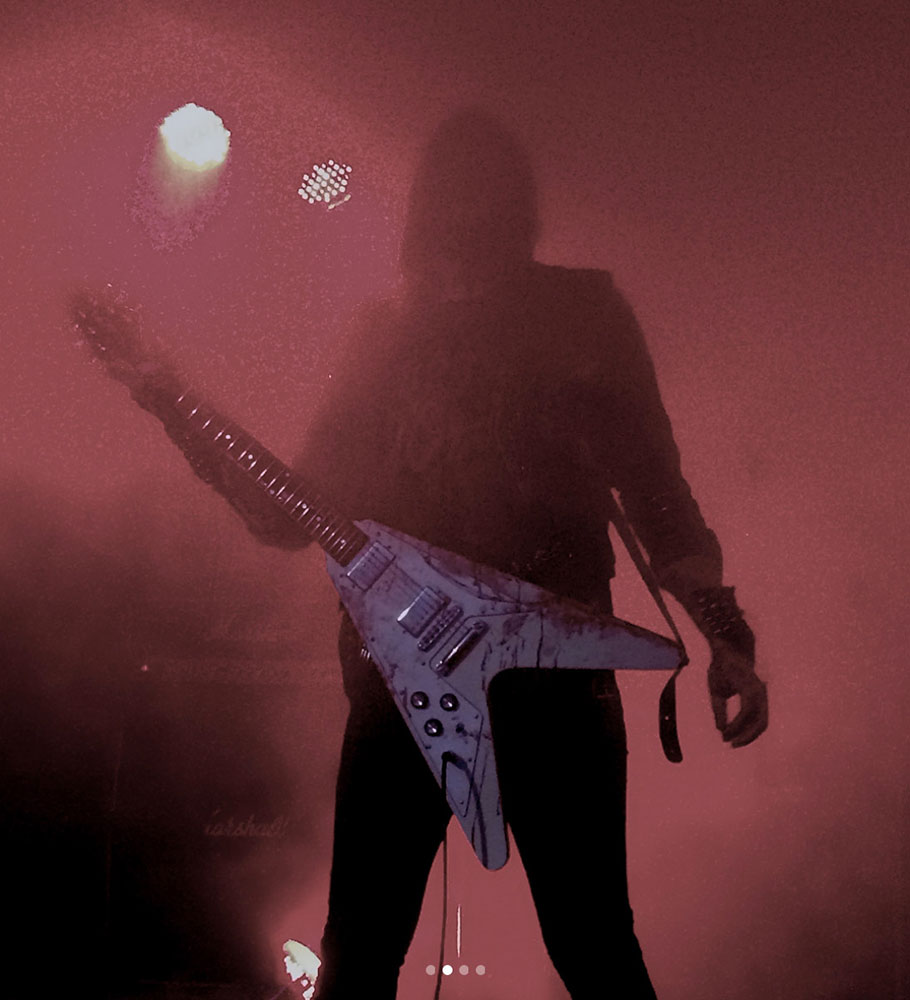
I was present for ULTRA SILVAM’s second-ever live performance, supporting BÖLZER in Stockholm, December 2017. I found their set extraordinary for a band that young, but nothing compared to the next time I saw them – at German festival Hell over Hammaburg in March 2020. Immediately after the show I ran into an equally impressed Deaf Forever editor Götz Kühnemund; he noted that ULTRA SILVAM was the most brutal live band he’d seen since DESTRÖYER 666 first started playing in Europe.
– Live performances are indeed one of our strengths. The reason we put out our “Live After Death” cassette was to capture that feeling on tape, just like KISS did with “Alive”. Nonetheless, I can’t say our albums lack this intensity to any greater extent. In fact, we make a conscious effort to bring the same mindset with us into the studio – which is why we refuse to follow any set BPM or similar modern nonsense, often settling for the first take without much afterthought. Of course, the blood has drawn some attention in both a positive and negative sense, which has surely coloured people’s perception of our shows.
ULTRA SILVAM‘s well-publicised habit of dousing themselves in rotten blood – which facilitates quite the olfactory assault – was discussed in our 2019 conversation.
– The blood was never meant as any kind of provocation. Sure, the fact that some are bothered by this is a direct consequence – but not what it’s all about. It has more to do with black metal legacy, tradition, and its obvious role in this macabre artform we have devoted ourselves to than us purporting to present anything new. WATAIN, for example, have been using blood for a long time and is probably the band most metalheads would associate with this type of stage show. Therefore, I mistakenly assumed that the metal crowd would be accustomed to it.
I take it you’ve received more complaints?
– Mm. We played at December Darkness – a festival in Norrköping where MARDUK are apparently some kind of house band – and I suppose there must have been an unusually high ratio of wimps present. I honestly didn’t think it was even possible to stir up such outrage in this day and age, but I’ve been proven wrong before. There was a huge outcry over our show; I read an endless stream of retarded Facebook comments, bringing to mind how people talked about Alice Cooper back in the 70s. Rumours and wild exaggerations were in circulation, like ‘They slaughtered animals on stage, I saw it!’ Now, that would admittedly have been pretty fucking heavy if it had actually happened, but sadly it did not.
What would you say the blood brings to your performance?
– In general, there is a stark difference when you perform black metal as opposed to some kind of domesticated humanist rock. The blood is just one aspect of all the ingredients we use to strengthen the live show: rotten leather, bullet belts, various sinister symbology, rusty spikes, and so forth… the combination thereof suppresses the mortal elements and helps bring us into a desirable frame of mind. In my world, striving for an aesthetic framework in perfect symbiosis with your music is a no-brainer. And sure, grown men carrying on like this with make-up, paraphernalia, and accessories could objectively be seen as ridiculous; but when one stands there and the stars align, there is no sense of ridicule whatsoever.
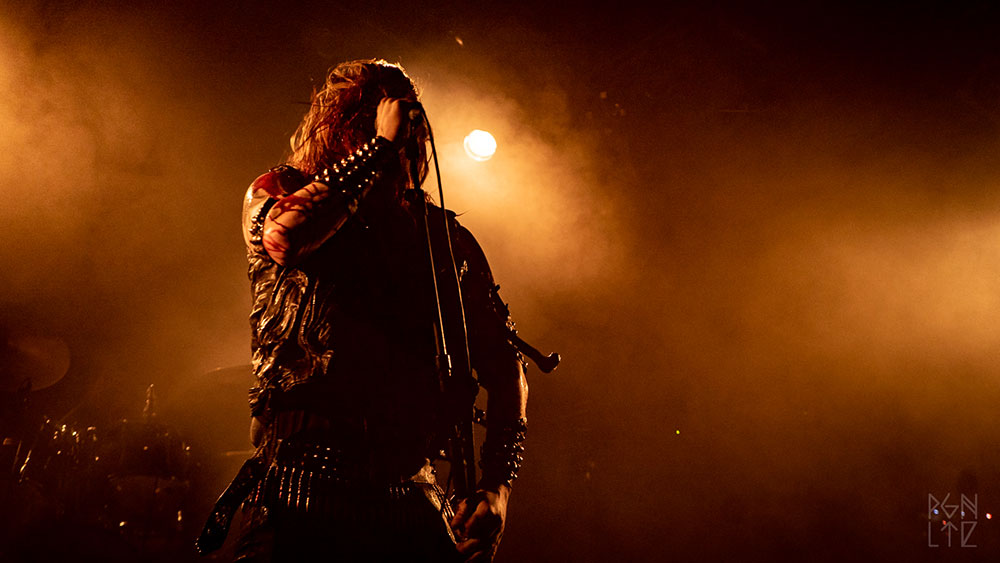
In my first ULTRA SILVAM interview, M.A. emphasised the importance of respecting and revering the fundamental elements of black metal – of which the aesthetics are a significant part.
– Shitty artwork and a total lack of evocative imagery are invaluable resources to indiscriminately filter out unworthy bands without wasting any time actually listening to them. If the visual representation is ignored, an album loses significant parts of its essence. I can’t for the life of me understand those who contact random ‘Michael Gonzales metal art’, looking for a ‘cool’ cover and then get some generic shit of a painting without so much as a critical reflection. In that case, one can just as well not bother with a physical release and instead put out the album as MP3s. Without intent, the artwork is nothing but mere cosmetics devoid of any meaning.
Another topic from our 2019 conversation was that of narcissistic metal has-beens. When I spoke with M.A. at the aforementioned Hamburg show, he mentioned that his musings had stirred up quite the response.
– In hindsight, that might not have been the most well-thought-out thing to say since I am infinitely more vexed with the younger generation. Don’t get me wrong: I am most certainly not taking anything back, but it’s important to be clear with what I meant. We don’t have to mention any names here, but we both know of Swedish bands which are shining examples of this. Some meaningless old farts who put out two demos in the 80s and now realise, ‘Wow, people still listen to us!’ It’s the classic mid-life crisis. ‘Come on lads, we’re putting the band back together! Let’s dust off the guitars and get a rehearsal place. By the way, does anyone know what metal sounds like these days?’
Undoubtedly, there have been a number of such examples over the past decade – and not just in Sweden.
– They’ve obviously not been part of this for the last twenty-five years, have no clue how things developed, and then try to stage a comeback with the same name – hoping to appeal to the cult-factor. No, I don’t find this even remotely acceptable. However, veterans who’ve consistently kept the faith are true firebrands. We have full respect for those who stuck to playing uncompromising metal all through the 90s, when the music elite mocked the whole genre, whereas many of their peers followed the latest trends and only returned to metal once it became fashionable again. In conclusion: hails to the stalwarts, fuck all the turncoats.
How long do you anticipate doing this yourself?
– Time will tell. In my youth, I often asked myself, ‘Are you really going to be running around on stage covered with blood at forty-five?’ That’s a very complex question. A select few can pull it off, but more often than not it just looks pathetic. Similar thoughts still pop up once in a while, but not quite as often. Regardless, there is of course no problem playing black metal as you approach middle-age, but bear in mind that the aggression and anger that was there in the early days – crucial ingredients for this type of music – tend to fade as the years pass. Just look at all the classic metal records fuelled by that energy! They were often created by musicians under twenty-five. The adolescent vitriol is essential for a band such as ours. In my case, it was quite enough just being out and about in town to be fully saturated with violent emotions. These days I live on the outskirts of Malmö, so I’m spared most of the scum infesting the city centre.
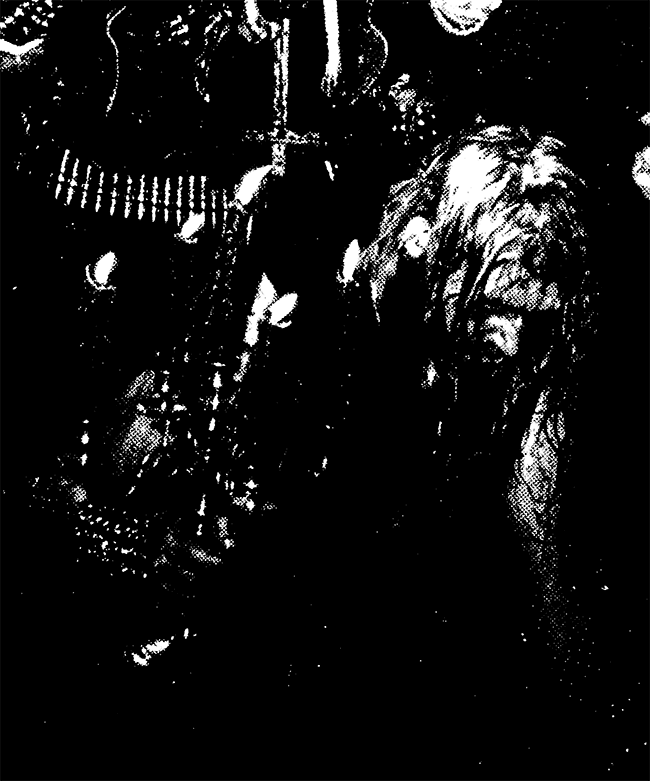
It will be interesting to see what happens next, seeing as how several label managers have asked me whether ULTRA SILVAM might be ripe for courtship. They are currently signed to classic Swedish underground label Shadow Records.
– I’ve mostly heard about this from others, but there have been some labels sniffing around at us. Fruitlessly so, I should add because we couldn’t be happier with Shadow Records. As things stand now, there is no reason to even consider any changes. I don’t think signing to some major label would change much for us. Both Per Gyllenbäck and Marcus Tena have their contact networks and that has already done a lot for us, which we are most grateful for. Take the tour with REVENGE, PROFANATICA, and MISÞYRMING – we have Tena to thank for that. I am also under the impression that J Read (REVENGE) wasn’t entirely opposed to having us along, which I suspect helped. Unfortunately, that tour was cancelled.
Have you performed live since the pandemic started?
– Yes, at Metal Magic this past summer. The billing was atrocious; DEATH SS were supposed to play, which would’ve been the only remotely interesting act, but no such luck. They cancelled, leaving us surrounded by melodic Danish death metal bands from the 90s. It was pretty much nothing to do but pack up and leave for home the moment we got off stage. That was our most recent show, and not a very rewarding one. Based on my experience, Denmark is the worst country to play in; it suffers from the very same problem that Skåne does.
Skåne is the southernmost county of Sweden; Malmö, ULTRA SILVAM’s hometown, is the biggest city in the region. Historically, Skåne used to be part of Denmark but has been under Swedish rule since the conclusion of the Great Northern War in 1721.
– Both places share a mutual heritage, so the lack of understanding for heavy metal does not appear too strange. As for future gigs: I honestly don’t know, considering the current circumstances. The whole situation is very confusing, but I suppose I’m getting used to it. There’s not much else to do than release the album, let it sink in with the listeners, and then hopefully get out there and play – hoping that people haven’t lost interest.
